Physical Address
304 North Cardinal St.
Dorchester Center, MA 02124
Ultrasound (US) has continued to evolve to become an extremely useful diagnostic imaging modality in the detection of various soft tissue pathologies around the elbow: tendons, ligaments, and nerves. The superficial location of the elbow allows for excellent high-resolution imaging of subcutaneous and periarticular structures utilizing high-frequency linear array transducers. Although there is an initial learning curve, and diagnostic accuracy remains operator dependent, the wide availability of US confers several advantages including cost-effectiveness, ease of patient accessibility, and absence of ionizing radiation. US offers the ability for close patient interaction, “real-time” dynamic assessment, provocative stress maneuvers, easy direct contralateral limb comparison, and imaging around surgical hardware that can potentially identify abnormalities that may not be evident with static magnetic resonance imaging (MRI) or computed tomography (CT).
US is considered appropriate for assessing soft tissue abnormalities and effective for diagnosing nerve or muscle pathologies according to current American College of Radiology (ACR) appropriateness imaging guidelines. Furthermore, a recent European Society of MusculoSkeletal Radiology Delphi-based consensus paper concurred that ultrasound is an appropriate first choice level imaging technique for the assessment of suspected epicondylitis, synovitis, septic arthritis, joint effusion, tendinopathy, and nerve compression syndromes.
Successful diagnostic musculoskeletal (MSK) ultrasound requires a combination of factors beyond regional anatomic and functional knowledge, including appropriate transducer selection, standardized scanning technique, understanding normal sonographic appearances, and awareness of potential US pitfalls and limitations. Whereas an in-depth review of sonographic technical principles is beyond the scope of this section, an understanding of basic principles is useful to better understand clinical benefits and limitations.
The integral component of US is the transducer (or probe), which serves as both a transmitter and receiver of sound waves utilizing a thin linear array of piezoelectric crystals. Vibrational mechanical energy is transmitted from the transducer into the underlying soft tissues as high-frequency sound waves, which subsequently encounter different tissue interfaces (known as acoustic impedances ) resulting in either wave reflection, through transmission, or refraction. Reflected sound waves returning to the transducer are transformed into electrical energy, with subsequent processing producing a real-time two-dimensional gray-scale or “B-mode” cross-sectional image of the particular region of interest ( Fig. 9.1 ). Static images or cine video clips can be stored for subsequent review.
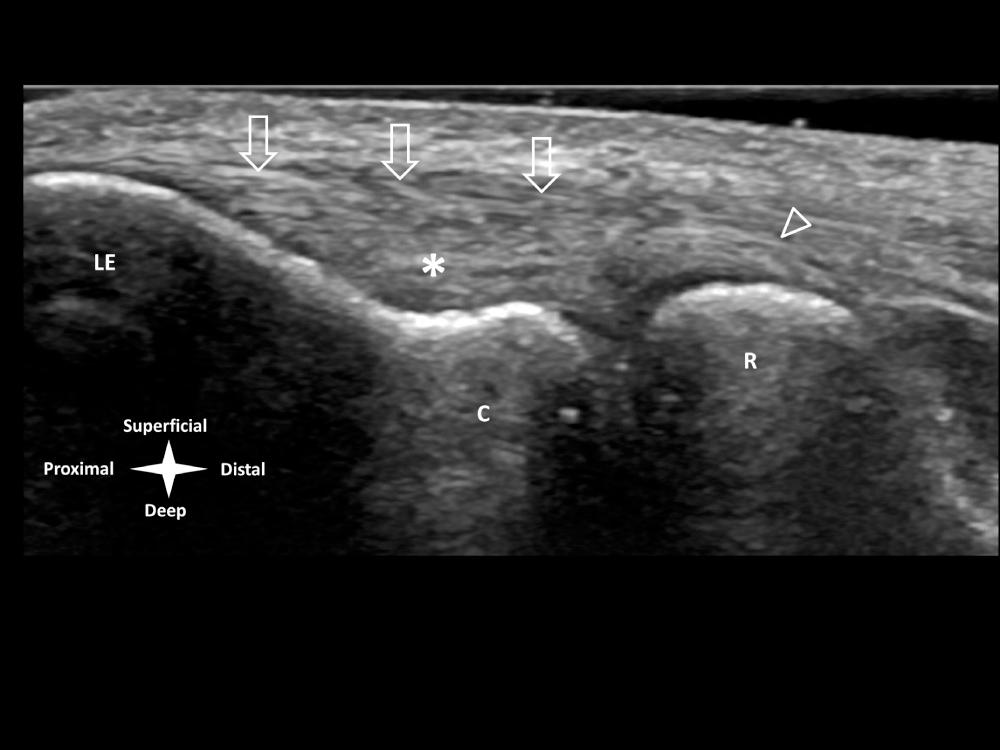
Utilizing high-frequency linear array transducers (10–20 MHz) for elbow US is essential in order to maximize image spatial resolution; clinically this is visually interpreted as the ability to delineate small adjacent structures as separate entities or identify submillimeter abnormalities. For example, the axial spatial resolution of a 10-MHz probe is approximately 0.15 mm, and spatial resolution will typically improve with increasing transducer frequency. In comparison to MR imaging, a 1.5-Tesla scanner using standard 0.5-cm slice thickness will yield a spatial resolution of approximately 0.47 × 0.47 mm. The downside of increasing transducer frequency is reduced sound wave penetration, which results in poor visualization of deeper structures. Transducer selection is particularly pertinent when imaging very muscular or obese patients. For very small superficial structures or around bony epicondylar prominences, a small footprint (“hockey stick”) high-frequency transducer is useful. Limitations of a smaller probe can be partially compensated by using extended field of view or virtual convex imaging techniques.
US machines are routinely equipped with “duplex” vascular imaging capabilities, which combine gray-scale B-mode imaging with real-time Doppler analysis. Therefore, both tissue structure and areas of directional vascularity are displayed simultaneously, giving both a morphologic and physiologic tissue assessment. Power Doppler imaging is an alternative vascular setting that gives a nondirectional assessment of blood flow that is less prone to image noise artefact so it is more sensitive for identifying subtle regions of hypervascularity in tendinosis or synovitis ( Fig. 9.2A,B ). Delineating increased vascularity at US is essentially analogous to identifying regions of contrast enhancement at CT or MR imaging.

Elbow anatomic structures are typically sonographically characterized according to four visual criteria: echogenicity, echotexture, vascularity, and anisotropy. Structures that appear white or bright are described as being echogenic or hyperechoic, representing regions with multiple acoustic impedance as a normal tendon or ligament. Regions that are relatively darker are described as being hypoechoic (or of decreased echogenicity), representing structures with less acoustic impedances such as normal muscle, hyaline cartilage, or degenerative tendon. Anechoic describes uniformly dark or black areas that are devoid of internal reflections, such as fluid within bursae, joint effusions, or cysts. Echotexture refers to the visualized internal composition or pattern of echoes within an individual structure.
Normal elbow tendons (distal biceps, common flexor, common extensor, biceps, triceps, brachioradialis) typically appear echogenic, noncompressible, and avascular and with a linear fibrillar echotexture representing the coordinated internal organization of longitudinal collagen bundles ( Fig. 9.3 ). Ligaments (lateral and ulnar collateral complexes) will also appear hyperechoic, avascular, and fibrillar. However, due to differences in internal architecture and the presence of multidirectional fibers, ligament fibrillar echotexture is typically more striated in comparison to tendons ( Fig. 9.4 ). Larger nerves (radial, ulnar, median, musculocutaneous), when viewed in short axis (cross section), have a characteristic honeycomb or speckled avascular appearance representing individual hypoechoic nerve bundles surrounded by echogenic connective tissue ( Fig. 9.5A,B ). Normal muscles have a hypoechoic, pennate structure with traversing echogenic septae and echogenic peripheral fascia. Normal articular hyaline cartilage will appear uniformly hypoechoic with a smooth demarcated surface margin, in comparison to underlying cortical bone, which has a characteristic smooth echogenic margin with complete posterior acoustic shadowing ( Fig. 9.6 ).
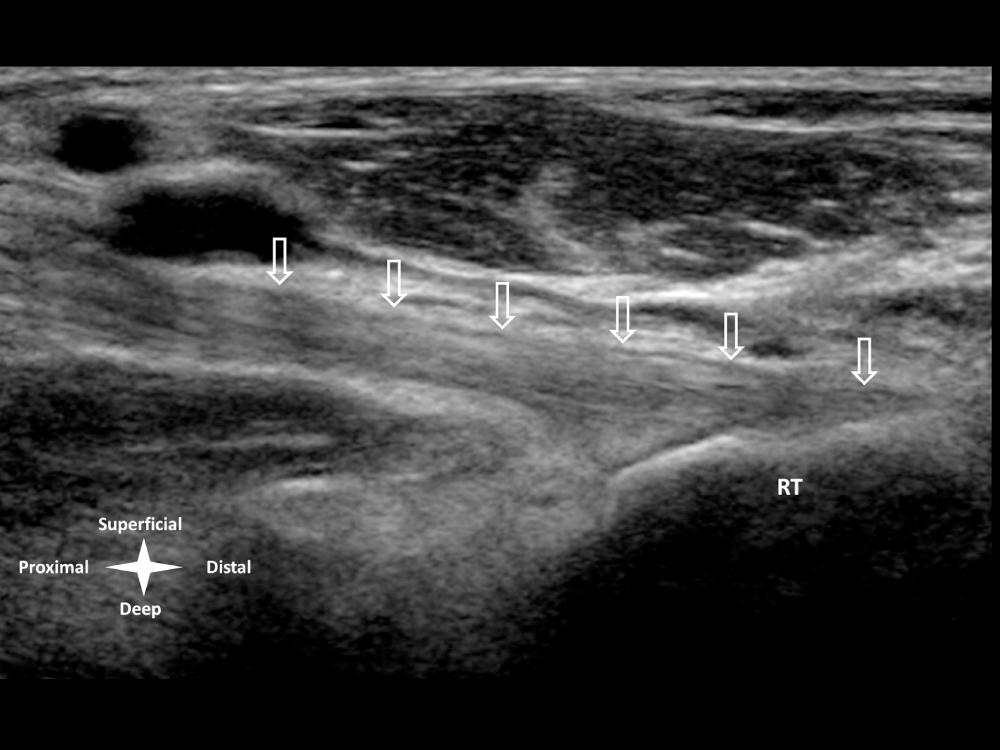
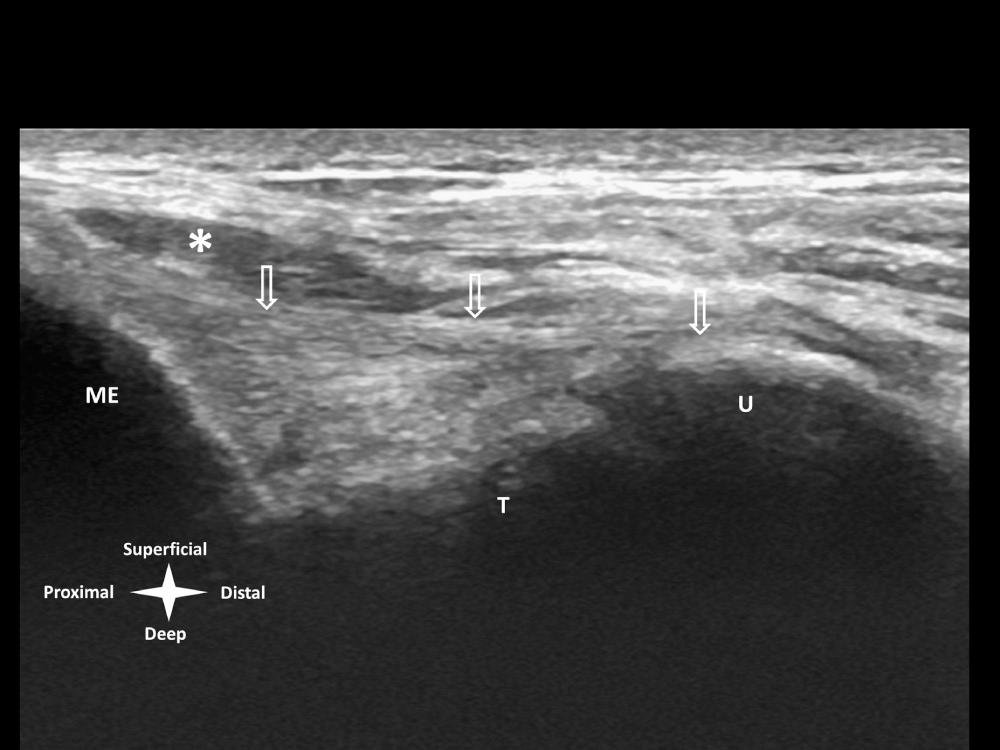
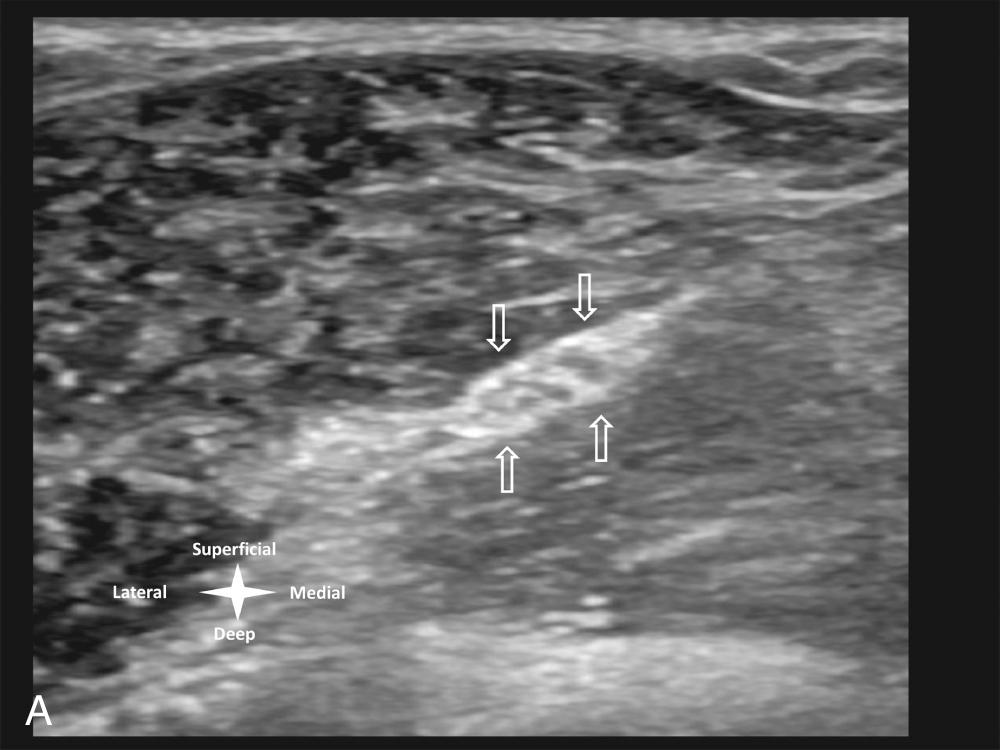
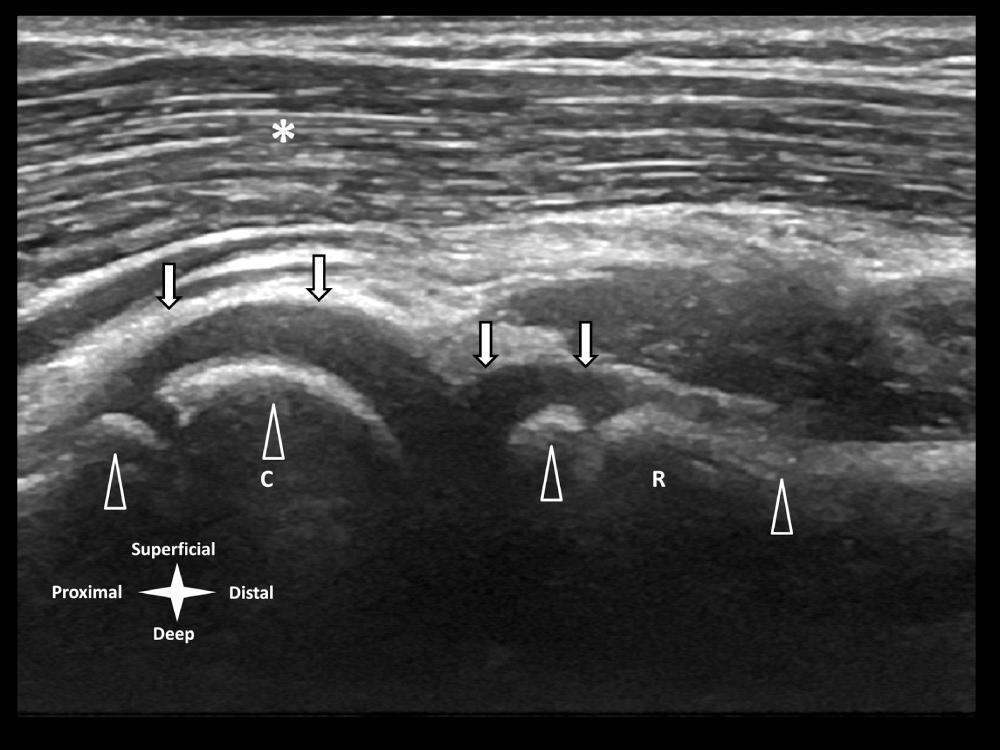
Anisotropy is an artefact routinely encountered during US and is a potential major pitfall. Anisotropy occurs when a conventionally echogenic structure appears hypoechoic due to inadvertent reflection of sound waves away from perpendicular to the transducer. Compact, reflective structures, such as tendons and ligaments, are particularly susceptible and can appear hypoechoic with only minor malalignment (5–10 degrees). Obviously, proper technique is required when imaging these structures to ensure they are properly assessed to avoid misdiagnosis of tendinosis or tendon or ligamentous tears ( Fig. 9.7 ). This pitfall serves to emphasize that elbow ultrasound is a dynamic imaging modality, and a suitable caveat to remember when reviewing static and cine clip images is that anisotropy can make “a normal tendon look abnormal but will never make an abnormal tendon look normal.”
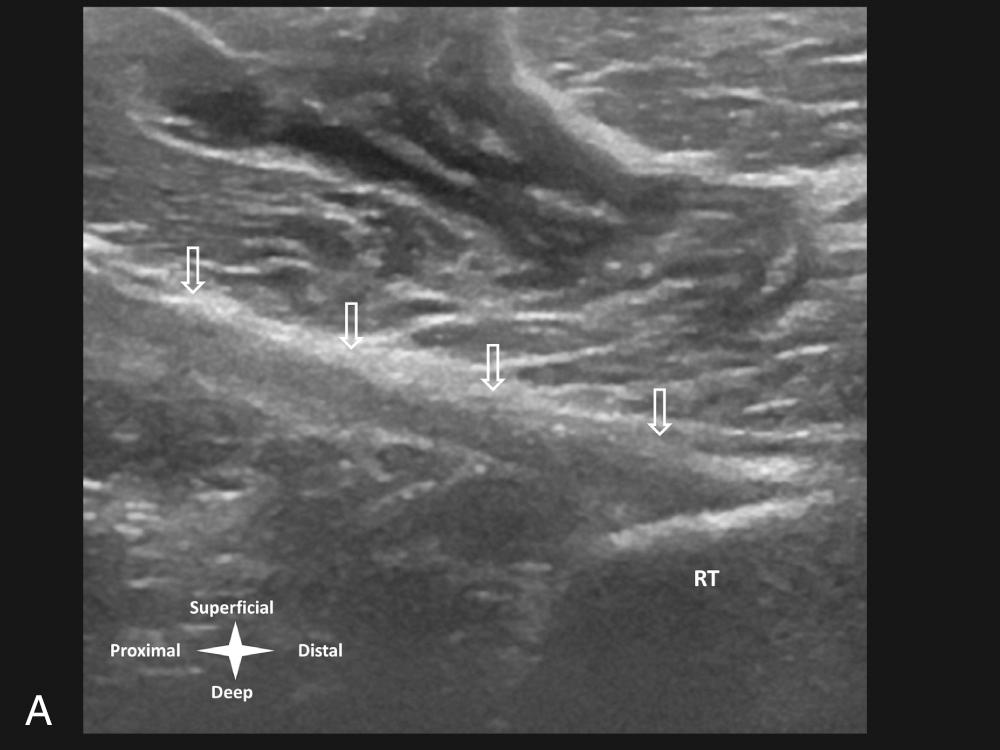
In routine US diagnostic practice, the elbow is divided into four compartments: anterior, lateral, posterior, and medial. Assessing the structures of each quadrant typically yields maximal diagnostic value. Specific structures within each quadrant are then orthogonally examined in both short and long axis views. When indicated, dynamic imaging can be performed to assess for nerve instability or tendon or collateral ligament injury. Detailed scanning reference guidelines are available on the American Institute of Ultrasound in Medicine (AIUM) and European Society of MusculoSkeletal Radiology (ESSR) websites.
Become a Clinical Tree membership for Full access and enjoy Unlimited articles
If you are a member. Log in here